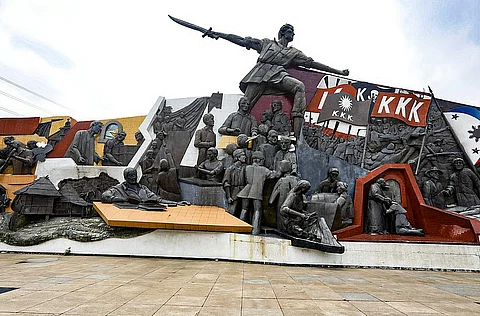
- NEWS
- the EDIT
- COMMENTARY
- BUSINESS
- LIFE
- SHOW
- ACTION
- GLOBAL GOALS
- SNAPS
- DYARYO TIRADA
- MORE

If you’re a San Juaneño, you have a thousand reasons to be proud. You are fortunate to live in a city that played a crucial part in our history during Spanish colonial rule.
As we all know, the Battle of Pinaglabanan — even if the Katipuneros didn’t win — signaled the start of a larger struggle that led to our country’s independence.
“There is no freedom without Pinaglabanan. That is what we often shout here in the city of San Juan,” Mayor Francis Zamora said in his speech during the 127th Philippine Independence Day celebration at the historic Pinaglabanan Shrine.
August 30, 1896, marked the first major battle of the Philippine Revolution that took place in Pinaglabanan, where the Katipuneros — armed with bamboo spears and bolos — attacked a gunpowder depot (el polvorin) and a water reservoir (el deposito) in San Juan del Monte, the city’s former name during the colonial period.
The Katipuneros, led by revolutionary leaders Andres Bonifacio and Emilio Jacinto, attempted to take over the gunpowder depot and the water reservoir because they believed they could defeat the Spaniards if they controlled Manila’s water supply.
“This place, which is now sacred, was attacked by Andres Bonifacio along with the Katipuneros because they believed that if they gained control of the water, they would win the revolution,” Zamora said.
“Many Katipuneros died, but this served as the signal for a larger fight that eventually gave the Philippines its freedom,” the mayor added.
Zamora is grateful that San Juan City celebrates Independence Day at the historic Pinaglabanan Memorial Shrine every year.
“It is important for our citizens to know the part that the city of San Juan played in our history,” he said.
Monuments of Emilio Jacinto, Andres Bonifacio and Jose Rizal were erected at the five-hectare Pinaglabanan Shrine to honor their heroism.
“The city government is taking many steps for our youth to know and understand this. If we do not take this to heart, there might come a time when we will not give importance to the freedom of the Philippines,” Zamora said.
For his part, Christian Bernard Melendez, senior shrine curator of Museo ng Katipunan under the National Historical Commission of the Philippines, said the Pinaglabanan Memorial Shrine is one of the key sites during Independence Day celebrations.
Other key sites include Luneta Park in Manila; Aguinaldo Shrine in Kawit, Cavite; Pamintuan Mansion in Angeles, Pampanga; Barasoain Church in Malolos, Bulacan; Monumento in Caloocan City; and the Mausoleo de los Veteranos de la Revolucion in the Manila North Cemetery.
“The significance of this area, why we have a celebration here, is because this is where the first battle for Philippine independence by Andres Bonifacio and our Katipuneros took place,” Melendez said.
After the Cry of Pugad Lawin, Bonifacio and his fellow Katipuneros attacked the El Polvorin de Aguas, which served as the Spanish military’s gunpowder storage facility.
“El Polvorin, that was like the storage of weapons for the Spaniards. So that was their first target. When they succeeded there, immediately after that, they went to El Deposito de Aguas, which is now the Pinaglabanan Memorial Shrine,” Melendez said.
“Bonifacio’s objective was to control the water supply and cut off the water supply going to Intramuros. You can see the reservoir here from the time of the Spaniards,” he added.
During Spanish colonial rule, El Deposito was the main source of water for Intramuros and nearby areas.
“During the Spanish era, their water source was from Marikina, in Wawa, Montalban. Marikina was the main water source, and from there, we had pumps and pipes. The water would flow down to El Deposito, and from here, the water would be distributed mainly to Intramuros and nearby areas,” Melendez said.
The Pinaglabanan Memorial Shrine and El Deposito de Aguas are considered historical sites, Melendez said.
“So the National Historical Commission of the Philippines recognizes the historical significance of the place. From El Deposito, it was made into the Pinaglabanan Memorial Shrine,” he said.
He said the government has built the Museo ng Katipunan and Museo El Deposito to further emphasize the historical importance of the area.
“The historical prestige of the place can be boasted by the San Juaneños,” Melendez said.
The National Historical Commission of the Philippines, with the help of the local government of San Juan City, is maintaining the peace and order, cleanliness, and sacredness of the shrine as a historical site.
“To our countrymen, the Pinaglabanan Memorial Shrine, the Museo El Deposito, is here to remind us that freedom should be cherished and protected,” Melendez said.
“As Filipinos, it is our duty to value our freedom because it is one of the basic privileges and rights we enjoy today,” he added.
